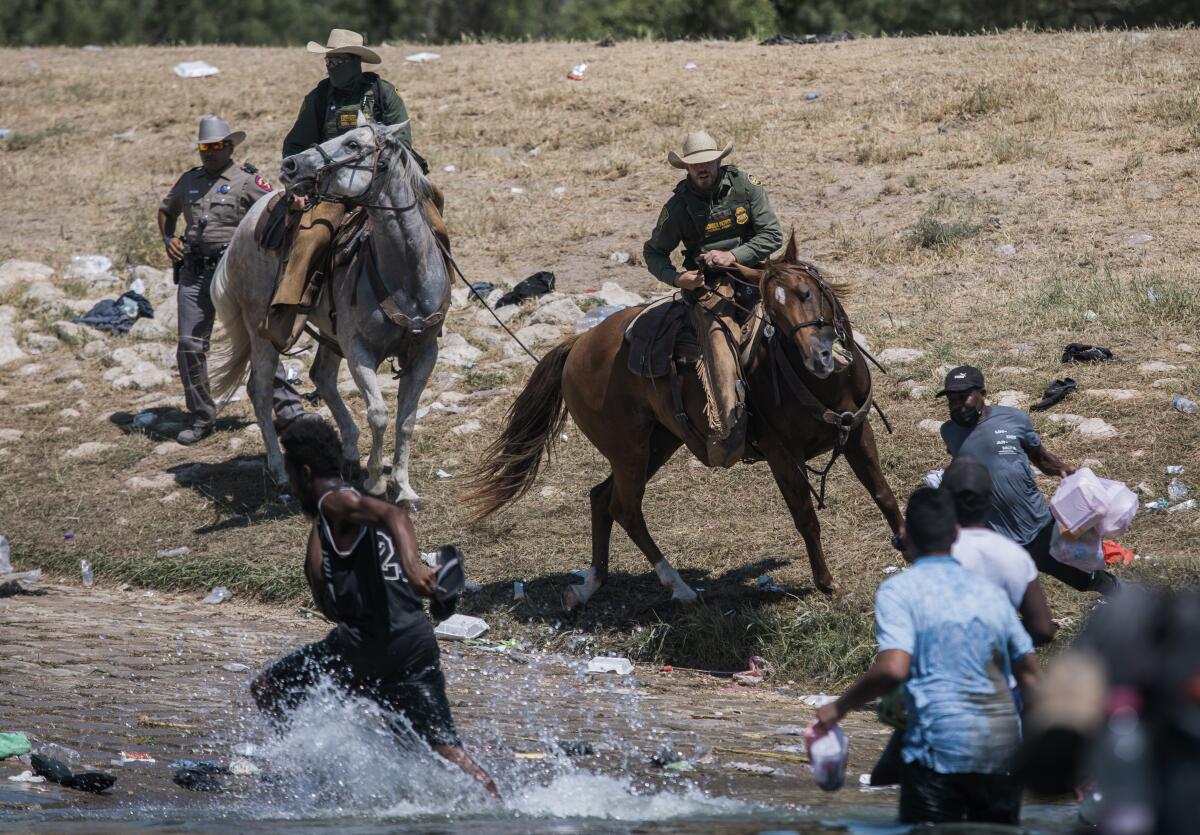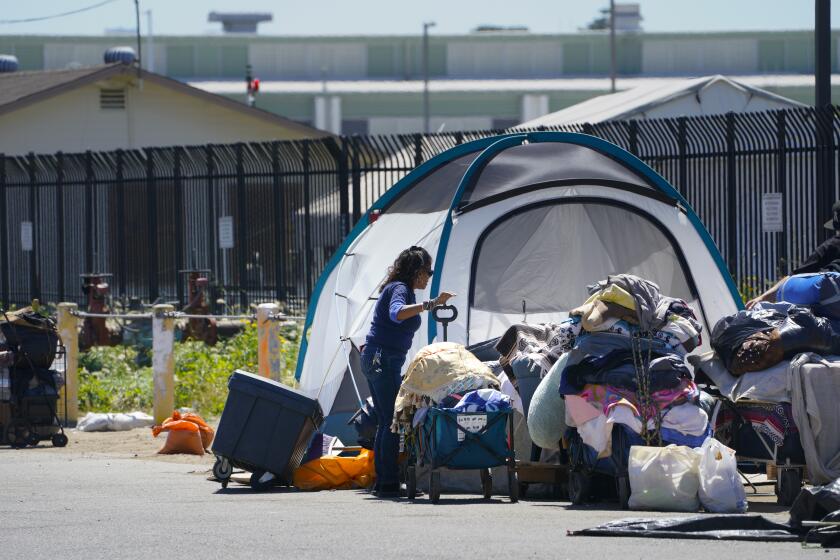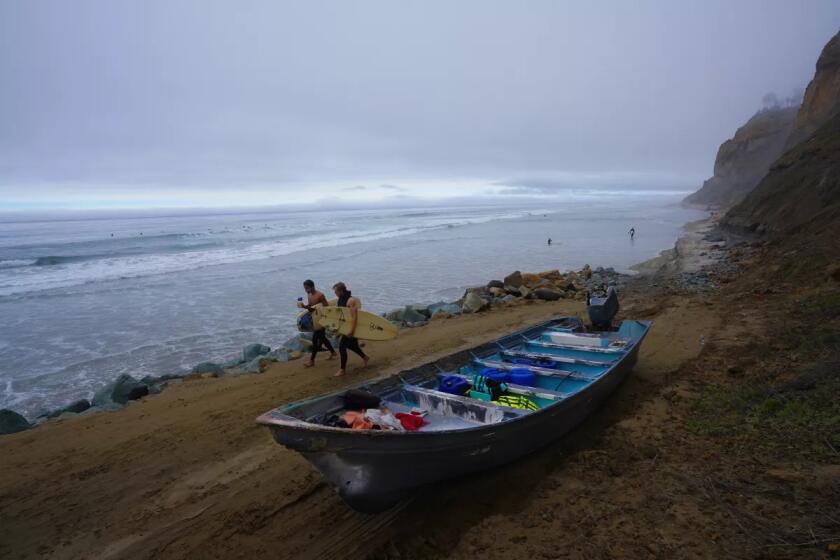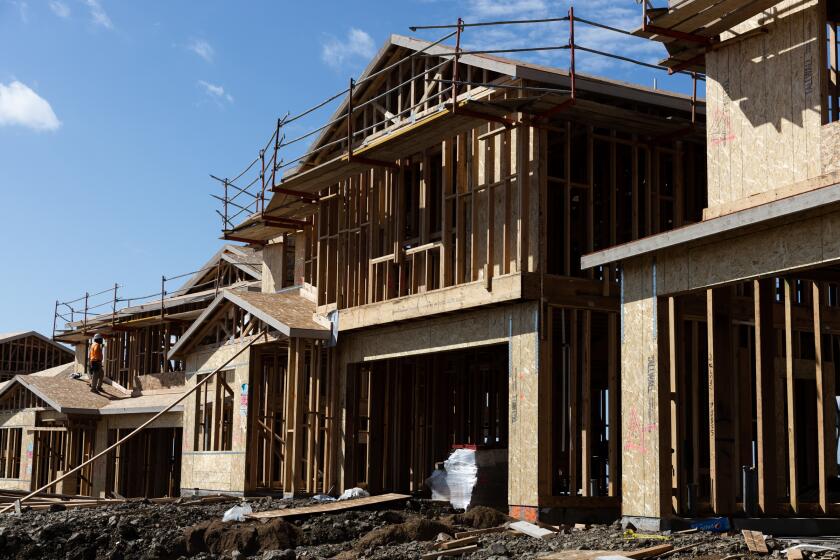A perfect storm of crises and instability leading Haitian migrants to seek U.S. asylum

Political science and history scholars discuss the web of complexities that make Haiti an unviable option for the latest wave of migrants who’ve crossed the U.S.-Mexico border
Of the nearly 15,000 Haitian migrants who were camped under a bridge along the Texas-Mexico border, a fraction of that number remains on the Mexico side of the border at the time of this writing, following immediate expulsions from the U.S. back to Haiti. The U.S. special envoy to Haiti resigned due to “… the United States’ inhumane, counterproductive decision to deport thousands of Haitian refugees and illegal immigrants,” according to Reuters. And widespread condemnation has come as a result of images of U.S. Customs and Border Protection agents on horseback chasing, and appearing to strike, migrants at the border.
The current situation is not only complex in real time, but becomes increasingly complicated by the layers of crises and instability that the island nation has been subjected to, particularly in recent years. To help provide historical context and perspective on policy around Haitian migration to the United States, are Jean-Germain Gros and Carl Lindskoog. Gros, a native of Haiti who’s lived in the U.S. for more than 40 years, is a professor of political science and public administration at the University of Missouri-St. Louis. He specializes in African and Caribbean politics, comparative politics, and public administration/public policy with a focus on global health. Lindskoog is an associate professor of history at Raritan Valley Community College in New Jersey, focused on issues of race, migration, empire and asylum. He’s the author of “Detain and Punish: Haitian Refugees and the Rise of the World’s Largest Immigration Detention System,” and a member of the Migration Scholar Collaborative, an organization of scholars working to decriminalize migration. (These interviews have been edited for length and clarity.
Q: There have recently been tens of thousands of Haitian immigrants camped out in Del Rio, Texas, on the border with Mexico. While we may typically associate migration from Haiti leading to an arrival in Florida, can you talk about the circumstances that have so many people from Haiti arriving in Texas right now?
Gros: Haitian migration to the United States, both legal and illegal, is longstanding and dates back to at least the 1960s, when François “Papa Doc” Duvalier was in power. In fact, it was in the 1960s when we saw the first wave of Haitians leaving Haiti. My parents were among that first wave of professionals who left for the United States, Canada, and Africa. Then you had the second wave in the late 1970s and early 1980s, with the so-called “boat people” arriving in South Florida. Then, we skip a couple of decades to 2010, when we had the earthquake.
After the earthquake, South American countries like Brazil and Chile, which were essentially led by left-wing governments, were sympathetic to the plight of Haitians and opened their borders. Haitians could go to Brazil and Chile, pretty much without a visa and did relatively well in these countries, as well as a few others in South America. Despite doing well in Brazil and Chile, my guess is that the United States was always their final destination, but they stayed put during the Trump administration because of the very harsh policies using the COVID-19 pandemic to deport anyone who showed up at the border. Those policies said that they represented a public health risk to the United States, so their case wouldn’t even be considered for asylum, they would just be deported.
When Biden came to power, he somewhat relaxed that policy toward refugees, but there was a misunderstanding [on the part of Haitian migrants] because that relaxation was for Haitians who were already in the United States. Biden granted those immigrants TPS, which meant that they were no longer slated to be sent back to Haiti [Temporary Protected Status allows people from designated foreign countries the ability to remain in the U.S. for a specific period of time without being deported, and in some cases also allows them to work and travel]. I think that was misinterpreted by Haitian migrants from South America; they read that to mean that the floodgates had been opened. Quite a few basically sold everything that they had to make their way north to the United States.
So, why Texas? The initial route was a land route from South America to Central America, to California. When [California] was blocked, they moved to Texas and crossed the Rio Grande River. The impetus for coming was the belief that that the U.S. was the ideal and final destination, and that once Biden came to power, they would have a more sympathetic administration than the Trump administration; but this was a misreading of Biden’s decision regarding TPS being applied to Haitians already in the United States.
Lindskoog: According to rights groups and journalists that have traveled to Texas and spoken to the Haitian asylum seekers there, many of these people have been in Central and South America, and in Mexico, for some time. They’re not necessarily coming directly from Haiti. After the earthquake in Haiti back in 2010, many went to Brazil where they were employed on things like the World Cup construction and the Olympics. Later on, they went on to Chile and other parts of South America. Over the past few years, many have tried to enter the U.S. across its southern border, but increasingly, it’s been difficult. In 2016, I believe, the Obama administration closed the border and resumed deportations to Haiti, which had been suspended since the earthquake in 2010.
When the Trump administration came to office, it really systematically dismantled the asylum system through things like the “Remain in Mexico” policy [the Migrant Protection Protocols program requiring asylum seekers in Central America to wait for their U.S. court hearings in Mexico] and metering, which was a way to just let a trickle of asylum seekers in at a time, effectively ending the possibility of seeking asylum. Seeking asylum is a right that all people have under our own federal laws, as well as international law. Apparently, many of those asylum seekers who were waiting for their chance to try to come to the United States, recently heard rumors going around that there was a way to get across to the United States at Ciudad Acuña [in Mexico, across from Del Rio, Texas], which is what brought the 15,000 or so Haitians to the encampment at Del Rio on the U.S. side. It’s really important to note that Haitians have been trying to get to the United States to seek asylum for years, and they’ve been effectively blocked from doing so. So, what’s happening now is really the result of all that has happened in these recent years.
Q: What are some of the current conditions of where many Haitian migrants previously were in South America, that have them leaving there and seeking asylum and residence in the United States?
Gros: Immediately after the 2010 earthquake, countries like Brazil and Chile were led by left-wing governments; these countries are now led by right-wing governments, governments that are less sympathetic to Haitian refugees. These South American countries are, at best, middle-income countries, they are not rich countries. Brazil has also been deeply affected by COVID-19, and the opportunities that Haitian refugees might have enjoyed when they first arrived in South America simply do not exist as much as they used to after 2010.
Once conditions in South America turned south, no pun intended, that, along with the belief that immigration laws under Biden had relaxed, combined to make the United States even more attractive. So, many of these people made great sacrifices selling belongings to make their way north, and many of them have family members already in the United States. They may have been thinking that if they just made it to the border, perhaps they could be left in the custody of a family member or friend already living in the United States. In fact, to some extent, this is happening. Some refugees are being transported to a processing center in Houston, Texas, where they hope to reunite with family members already in the country.
Lindskoog: Haitian migrants, really starting from the time that they chose to leave Brazil in South America, have faced a really dangerous journey all the way north. That journey has involved violent attacks, robberies in the countries that they pass through, sometimes sexual violence, attacks by gangs. They’ve been imprisoned by Mexican authorities and Central American authorities, they haven’t been able to make a life and a living in many of these countries, nor remain safe. Many of these places are quite inhospitable to them. They were hoping that they could do so in the United States, and that’s what’s motivating them to come this far north.
Of course, things are terribly dangerous in Haiti, as well. There was political crisis in Haiti, even before the July 7 assassination of Jovenel Moïse. Soon after that, we know that there was a 7.2 magnitude earthquake, which very seriously compounded a lot of the problems that were already there. The Biden administration has even acknowledged, recently, that things were much too dangerous and difficult to send people back to Haiti, extending Temporary Protected Status for Haitians; but that’s just what the Biden administration is doing now, with those asylum seekers along the U.S.-Mexico border. So, there’s a big contradiction between what the Biden administration has said and done recently, and what it’s doing, as we speak, with the asylum seekers there.
Q: And what contributed to their need to leave Haiti for Central America?
Gros: As a result of the earthquake, hundreds of thousands of people may have died. An economic situation that was already dire, became even worse. For all intents and purposes, Haiti is what you would call a failed state, so there was never any kind of reconstruction. Furthermore, the aid pledged by the international community to Haiti was never really delivered, and was certainly not delivered to the Haitian government. Most aid these days is channeled through non-governmental organizations from the donating country, which means that the aid that the U.S. gives to Haiti through U.S. NGOs, will somehow end up back in the United States. So, there was never any serious reconstruction due to the failed nature of the Haitian state, corruption, and the aid practices of the international community. Very importantly, is the fact that the United Nations brought cholera to Haiti, that ended up killing between 8,000 to 10,000 Haitians. So, the fact is, the international community, led by the United States and the United Nations, have not done well by Haiti; but the Haitians are also responsible for their own plight. There is enough blame to go around for everyone in the Haitian saga.
Lindskoog: As we’ve noted, many have been in South or Central America for years, but there have been many people fleeing Haiti, if they can, because of the recent back-to-back crises there: The political crisis, which was intensified by the Moïse assassination; and the earthquake in August, and even the 2010 earthquake, are events that Haiti hasn’t really recovered from. It’s really been a long history, depending on how far back you go, and the international community not only failed Haiti with all of its promises to help rebuild, but in many ways has made things worse. For example, the United Nations peacekeeping forces contaminating the water, leading to a cholera epidemic that has killed over 10,000 Haitians. The very recent things that have happened just this year, happened within an already very difficult situation. That’s part of what, not only has driven more people to leave Haiti, but makes it much too dangerous to reasonably or humanely send anyone back there right now.
Q: What do you think it is about the Biden administration’s response to this situation in Texas, that strikes some activists and experts as a “shockingly hard line”?
Gros: The initial decision once the migrants started arriving en masse, was apparently to essentially send all of them back to Haiti, so I think that was the shocking part. There was to be, I think, an increase in the number of flights. Under international law, people seeking asylum should at least be given a hearing; apparently, the decision was to simply send them back without a hearing. So, I think that is where that judgment is coming from because this was also the policy of the Trump administration. The Biden administration was basically being accused of maintaining and following the Trump administration policy, despite the fact that Biden had criticized Trump during the 2020 presidential campaign. In the past [week], the policy has been moderated, somewhat. They are letting some refugees in. That’s something, whereas, initially the idea was to let no one in. So, you are seeing the policy be adjusted as a result of the criticism, but the deportations will continue, except that the deportations will not take place indiscriminately.
Lindskoog: I think that, just the image of the Border Patrol agents on horseback was shocking to many. It really helps people visualize just what was happening, so I think that really shook people into consciousness about the situation.
I also think the Biden administration’s continued illegitimate use of what Trump had installed with Title 42, to expel asylum seekers without even allowing them to file asylum claims, which they have the right to do. Title 42 is supposed to be something that allows officials to keep more and more people out, in the interest of public health, but the Trump administration used the public health crisis [of the COVID-19 pandemic] as a pretext for keeping out asylum seekers. The Biden administration has continued to do that. Other members of the Biden administration, like [U.S. Department of Homeland Security Secretary] Alejandro Mayorkas, tried to make a forceful statement, saying, “If you come to the United States illegally, you will be returned.” What everyone should know is that it’s not illegal to seek asylum, that is protected through our own federal law, through international law.
I also think that, part of why people are shocked by what the Biden-Harris administration is doing to Haitians on the southern border, is because they believed that it would be a substantial contrast to the Trump administration. President Trump was openly racist in his language used to describe Haitians and Africans. Racism clearly informed the Trump administration’s decision to exclude and ban certain migrants. The Biden-Harris administration would like us to believe that they were halting the explicitly racist treatment of Black migrants, but what we’re seeing in the mass expulsion of Haitian asylum seekers demonstrates that there’s really more continuity than change between Trump and Biden, at least in this respect. Now, this might not be too shocking for those of us who know about the long history of bipartisan, anti-immigrant exclusion and criminalization, but for those who believed Biden would be fundamentally different from Trump, this is coming as a particular shock.
Q: There’s been a strong reaction to photography and video footage showing U.S. Customs and Border Protection agents on horseback, chasing, and in some cases, seeming to strike Haitian immigrants as they attempted to apprehend them. Personally, it was disturbingly reminiscent of this country’s history of overseers on plantations. Is this a typical, or even previously practiced, form of apprehending undocumented immigrants? Are there any potential reasons you can think of for agents to take this course of action in this situation?
Gros: No, as far as I know, no other refugee group has been treated this way. It’s as if they are trying to catch cattle. I don’t recall authorities on horseback, running after refugees from other countries this way. Of course, when you are talking about the U.S., there is always a racial dimension to everything, and I would be surprised if there was not a racial dimension to that. So, it’s pretty hard to watch and I think it’s unprecedented in the way we have treated refugees. Keep in mind that the United States, the Trump administration, was not exactly lenient toward refugees, but this particular method seems to be a first. There seems to be kind of new ways of being cruel. So, this is sort of another rung on the ladder of cruelty, on the part of immigration officials.
Lindskoog: To answer your first question, yes, there is a long history of border patrol agents using violence to apprehend and remove migrants, especially Mexican migrants, but others as well. This dates back to the creation of the Border Patrol in 1924. Even before, as you noted, in the slave patrols and in the policing of the movement of Black people and other racialized minorities; so, I agree with you that those were horrifying images and videos, especially if you recognize it in the long history of racial terror carried out against Black Americans, Black migrants, and especially immigrants of color.
To speak to your second question, I would say that to use this sort of violence and terror on people who are just trying to survive — they were trying to get some food and water, and were trying to exercise their rights to seek asylum — is appalling and utterly indefensible. Violence has been institutionalized in immigration enforcement in this country for many decades, there’s lots of examples of it. It doesn’t have to be this way, but that’s the way it is now and the way it’s been for some time. This is just the current manifestation of what’s been happening in plain view, and sometimes behind the scenes, for a long time.
Q: There obviously aren’t any simple or easy solutions to this current situation, but do you see any potential alternatives to the current expulsion policy?
Gros: As long as this world is divided between nations that are ultra-rich and those that are ultra-poor, nations that are ultra-rich will always be a magnet for citizens from countries that are ultra-poor. We’ve been trying to bring about development in poor countries since World War II, and not succeeded. That’s the solution, to basically make the world less unequal. That is unlikely to happen. You can build the wall, as the Trump administration tried to do, but that, at best, smacks of desperation rather than a real solution. Again, the ultimate solution is to improve conditions in poor countries, but no one seems to know exactly how to do that. You could have more humane immigration policies. For example, you can increase the number of immigrants that you take in legally every year, but the key is the disparity between the rich and poor countries, and the tremendous gap that exists between the haves and the have-nots, both globally and locally. As long as you have that gap, people will move with their feet from conditions of desperation, to conditions of hope.
Lindskoog: Yes, absolutely. Here’s an alternative to what the Biden administration is doing now, and what advocates and human rights activists are calling on them to do: They can allow these asylum seekers to exercise their rights under federal and international law, to allow them to come into the country to file their asylum claim, and then give them fair, transparent asylum hearings as they’re obligated to do, according to the law. They can give them food, water, clothing, and treat them like human beings. Don’t place them in detention facilities, but resettle them while they await the processing of their asylum claims. They need to halt all expulsions and deportations to Haiti for the same reasons that the Biden administration already acknowledged it was doing before, when it extended Temporary Protected Status. They need to further extend TPS to those Haitians who arrived recently, and are continuing to arrive now. I would say they need to raise the cap on refugees so that there are more spots available, just for situations like this, especially because we’re dealing with the fallout of the last years where the asylum system and the refugee system has been systematically dismantled. They need to rebuild that to make the space open again. All of those things together are a humane alternative to what is happening now and what they’re doing, which is utterly inhumane.
Get Essential San Diego, weekday mornings
Get top headlines from the Union-Tribune in your inbox weekday mornings, including top news, local, sports, business, entertainment and opinion.
You may occasionally receive promotional content from the San Diego Union-Tribune.












